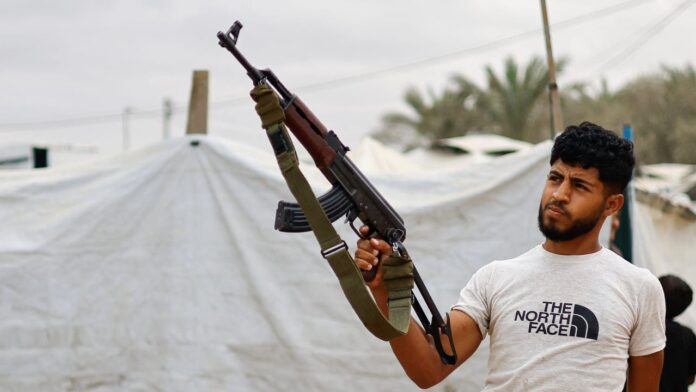Security Breakdown Engulfs Gaza Following Ceasefire
Gaza is witnessing severe unrest following the fragile ceasefire agreement between Israel and Hamas. According to Palestinian sources, intense armed confrontations have broken out across the Gaza Strip as local factions and clans openly rebel against Hamas’s authority. Reports describe the situation as chaotic, with several neighborhoods caught in violent crossfire.
The most intense fighting has been recorded in Beit Lahia and the Sabra neighborhood of Gaza City, where Hamas forces clashed with local militias and tribal groups. The violence has left multiple casualties, including Muhammad Imad Aql, son of a senior Hamas commander who was previously assassinated.
Fierce Battles in Beit Lahia and Gaza City

In Beit Lahia, gunmen linked to Ashraf al-Mansi engaged in a prolonged firefight with Hamas operatives. Simultaneously, in Gaza City’s Sabra area, the Dajmash clan resisted Hamas forces in a confrontation that quickly escalated into a neighborhood-wide battle.
Witnesses reported that Hamas surrounded the al-Dhamsha family neighborhood, forcing residents to flee their homes. Schools and residential buildings were evacuated as masked fighters and rooftop snipers took positions across the area, turning parts of Gaza City into a war zone.
Hamas Faces Rebellion from Powerful Clans
Palestinian insiders describe the growing rebellion as one of the most serious internal challenges Hamas has faced since taking control of Gaza. The organization views these armed clans as direct threats to its rule and fears that external forces may exploit their dissent.
During the recent conflict, Hamas allegedly executed the mukhtar (chief) of the Dajmash clan, suspecting him of cooperating with Israel. To suppress further uprisings, Hamas commanders have reportedly attempted assassinations of opposition figures, including Yasser Abu Shabab, leader of the Rafah-based militia. The attempt failed, further emboldening the anti-Hamas factions.
Rival Commanders Defy Hamas Rule

In the southern city of Khan Yunis, Hussam al-Astal, commander of a rival militia, issued a fiery statement on social media condemning Hamas’s rule. In his post, he declared:
“To all the Hamas rats — your tunnels are destroyed, and your rights are gone. Repent before it’s too late. From today, there is no Hamas.”
Al-Astal also accused Hamas of using hospitals and mosques as cover during recent battles. He claimed that Hamas militants fired rocket-propelled grenades and explosives from within Nasser Hospital and a nearby mosque while fighting members of the al-Majaida clan.
According to al-Astal, an Israeli airstrike, coordinated with clan fighters, eliminated at least 22 Hamas members during the confrontation. The IDF spokesperson later confirmed that such a strike took place, though without commenting on coordination claims.
Calls for Revenge and Retaliation
In response to the spreading rebellion, Hamas leadership vowed to retaliate against what it described as “traitorous” Palestinian groups collaborating with Israel. Media channels linked to Hamas have published threats to “settle accounts” with the leaders of rival militias — naming Abu Shabab, al-Astal, Rami Khalas, and al-Mansi among their primary targets.
Hamas accuses these groups of exploiting the ceasefire to expand their influence, particularly in regions left outside the initial Israeli withdrawal zones — including eastern Rafah, Beit Hanun, Beit Lahiya, and eastern Khan Yunis. These territories remain under the control of Palestinian factions that openly reject Hamas authority.
Defiance Among Rebel Militias
Despite Hamas’s threats, rival groups continue to declare resistance. Al-Astal’s men, along with Abu Shabab’s Popular Forces, insist they will not surrender.
“Let the Hamas dogs not celebrate — we are still here,” al-Astal proclaimed. “They will be the ones to fall.”
A senior source close to Abu Shabab’s group also expressed determination to continue fighting, stating:
“Just as Hamas eventually agreed to release hostages under pressure, it will soon have no choice but to surrender its heavy weapons.”
A Fractured Gaza at a Crossroads
The escalating infighting has created a security vacuum in parts of Gaza, threatening to unravel the fragile ceasefire arrangement. Analysts warn that if Hamas loses control of key areas, Gaza could descend into a patchwork of rival militias, each seeking dominance in the post-war landscape.
For now, the situation remains volatile, with reports of sporadic gunfire, checkpoints, and mass evacuations continuing into the weekend. The Palestinian Authority and international mediators have yet to comment publicly, as the Gaza Strip teeters on the brink of another wave of internal conflict.

